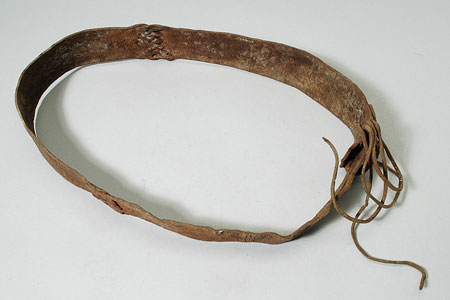Accession Number:
1940.7.088
Country:
Sudan
Region:
[Southern Sudan] [Al Istiwa'iyah] [Equatoria] Eastern Equatoria ?Jebel Imatong
Cultural Group:
[Imatong]
Date Made:
By 1940
Materials:
Animal Hide Skin
Process:
Perforated , Plaited
Dimensions:
L = 1065, max W = 56.5, th = 3; belt loops W = 7, th = 6 mm [RTS 31/3/2005].
Weight:
193.5 g
Other Owners:
Samuel P. Powell
Field Collector:
Samuel P. Powell
PRM Source:
Samuel P. Powell
Acquired:
Loaned July 1940
Collected Date:
By 1940
Description:
Rectangular belt or waist ornament, made from 3 pieces of thick animal hide, probably buffalo, with the hair removed from the outside and the surface coloured with red ochre or pigment (Pantone 478C).
Each piece is roughly similar in length, and is fringed at one end with a narrow slit cut at the base of each rectangular fringe tab; each tab then passes through the slit in the adjoining fringe, weaving the two parts firmly together while creating a thickened decorative band at the junction.
The central hide strip is fringed at both ends, while the side pieces have one fringed end and one flat-cut end.
One of these ends is quite broad, and has been perforated twice along its upper and lower edges, with two short plaited hide loops attached to the front of the belt through these holes; the other end is narrower and can be fitted through these loops to hold the belt in place.
The loops are each made from 2 narrow hide strips, perforated along their lengths and interwoven; at their base, they are left unplaited and hang freely as a long, narrow fringe.
The belt is complete and intact; there is a small circular hole through the centre of the body that has no obvious function, and some white flecks of paint over the outer surface.
It has a weight of 193.5 grams, and is 1065 mm long, with a maximum width of 56.5 mm and thickness of 3 mm.
The belt loops are 7 mm wide and 6 mm thick.
Collected by Samuel P. Powell from the modern administrative district of Eastern Equatoria, and loaned to the Pitt Rivers Museum in 1940. It came from the 'Imatong tribe', who are presumably a group located somewhere around Jebel Imatong, a mountain peak in Southeastern Sudan, south of Torit. This object was used by women as a belt.
Rachael Sparks 14/9/2005.
Collected by Samuel P. Powell from the modern administrative district of Eastern Equatoria, and loaned to the Pitt Rivers Museum in 1940. It came from the 'Imatong tribe', who are presumably a group located somewhere around Jebel Imatong, a mountain peak in Southeastern Sudan, south of Torit. This object was used by women as a belt.
Rachael Sparks 14/9/2005.
Primary Documentation:
Accession Book Entry
[Loans II, p.
308] - ESTATE OF S.P.
POWELL, C/O N.H.
HASLAM, Esq.
Manager, Westminster Bank, Stony Stratford, Bucks.
Collected by himself.
Data from his labels and notes.
[p.
313] From the IMATONG TRIBE.
EQUATORIAL PROVINCE, ANGLO-EGYPTIAN SUDAN.
[p.
314] 1940.7.088 - Woman's belt of thick hide, probably buffalo.
Related Documents File - Appears on undated typed list: "Imatong woman's belt of thick hide, probably buffalo". List is annotated by hand on back: "List of Curios" and "Far from complete" [RTS 16/12/2003].
Pitt Rivers Museum label - Woman's leather belt. Thick hide, probably buffalo. IMATONG. S.P. Powell, 1940.7.088 [brown luggage label, tied to object; RTS 31/3/2005].
Related Documents File - Appears on undated typed list: "Imatong woman's belt of thick hide, probably buffalo". List is annotated by hand on back: "List of Curios" and "Far from complete" [RTS 16/12/2003].
Pitt Rivers Museum label - Woman's leather belt. Thick hide, probably buffalo. IMATONG. S.P. Powell, 1940.7.088 [brown luggage label, tied to object; RTS 31/3/2005].






